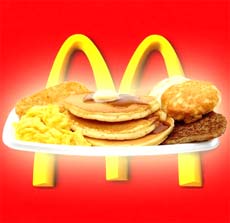
But other choices won’t be so clear-cut, like the Double Cheeseburger with 440 calories or the Southwest Salad with Crispy Chicken, which weighs in at 450. McDonald’s highest-calorie item isn’t a burger at all, but the 1,150-calorie Big breakfast with hotcakes and large biscuit. And the healthy-sounding 22-ounce mango pineapple smoothie matches the 350 calories in the grilled chicken sandwich.
McDonald’s USA Nutrition Facts for Popular Menu Items is available at : http://nutrition.mcdonalds.com/
Some chains, such as Panera Bread Co. (PNRA) and Au Bon Pain, already post calories on their menus, but McDonald’s is the largest chain and the first fast-food company to do so on a national level.
The push is part of an effort to get out ahead of federal menu-labeling requirements. There is a market need to it tooMcDonald’s want to convey to customers that its not just selling junk food. The company last year added apples to all of its kids’ meals and made the servings of fries smaller.
Some regional studies suggest that having nutritional information available when ordering a meal prompts people to buy healthier items. Other studies have found no such change in consumer behavior. But considering how prominent restaurants have become in the American diet, any change could have an effect on obesity rates.
Americans now consume roughly a third of their calories from restaurants, up from less than a quarter in the 1970s, according to the U.S. Department of Agriculture. And people spend about half of their food budgets at restaurants now, compared to a third in the 1970s.
A Stanford Graduate School of Business study found that when Starbucks Corp. (SBUX) began posting calorie information in its New York City stores in April 2008, as required by city law, customers ordered items containing 6% fewer calories on average per transaction.
“If we see a similar effect from other chains you’d see about a 30-calorie per person per day decrease,” said Margo Wootan, director of nutrition policy at the Center for Science in the Public Interest. “The thing about obesity is it’s caused by a slow, steady creep in people’s weight over decades. For most of us, we’re gaining one to two pounds per year steadily over decades and end up being 30 to 50 pounds overweight. The obesity epidemic is explained by about 100 extra calories per person per day, so if we get a daily 30-calorie decrease from menu labeling, that’s huge.”
Credits:http://finance.yahoo.com/